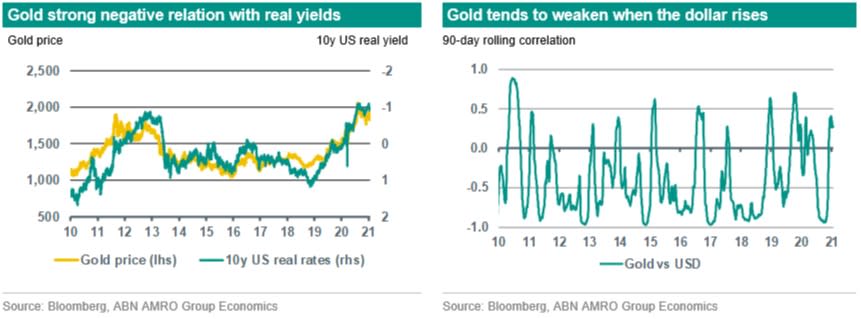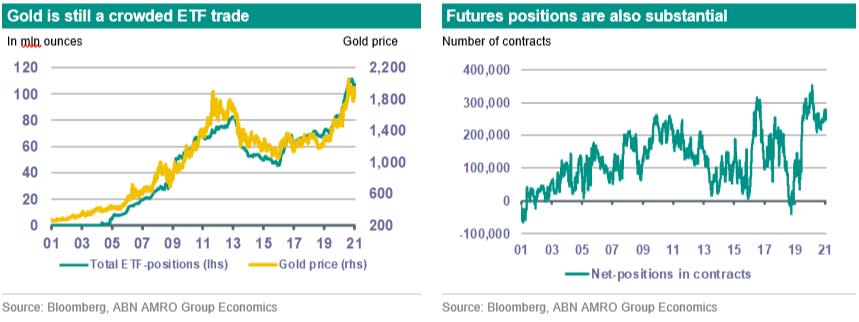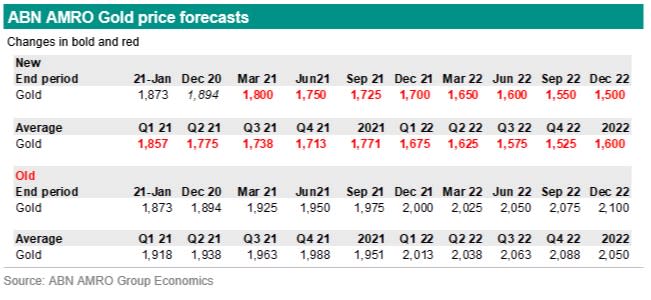Precious metals Watch – Gold has peaked
In this publication: We change our gold outlook following our changes in US rates, in our Fed view and US dollar. We now expect slightly higher US nominal and real yields, a less dovish Fed and a moderate rise in the dollar. All negatives for gold prices so we think that gold prices have peaked. But concerns about US fiscal deficit will dampen the downside in gold. Our new year-end 2021 forecast is USD 1,700 per ounce (was USD 2,000 per ounce).
Introduction
On 16 December we published our Gold Outlook with the title “Outlook is still positive but…”. Since then a lot has happened. Weakness in the dollar pushed gold prices towards USD 1,960 per ounce. This was close to a former peak at USD 1,963 per ounce. When prices failed to move beyond this level, some investors took profit on their long positions. US nominal yields started to rise on the back of expectations of more fiscal stimulus in the US and comments from a few Fed officials. Meanwhile the dollar staged a recovery because of higher yields but also due to some deterioration in investor sentiment. As a result gold prices have dropped towards the 200-day moving average again.
New outlook for gold
The outlook has deteriorated sharply. We no longer expect higher gold prices. There are several reasons for this. First, we have changed our view on the Fed. We now expect asset purchases to continue at the current pace at least until the end of 2021, with a tapering and end to purchases in the course of 2022. It could be that a period of higher core inflation later in the year convinces some FOMC members that they are at that point ‘on track’ (as per the Fed’s forward guidance) to overshoot 2% for a time. In that case, we could well get the first hike in 2023, which is much sooner than previously expected. Any hikes would be extremely limited, given the Fed’s new policy framework, which aims to raise long run inflation expectations. A less dovish Fed is negative for gold prices.
Second, we no longer expect lower nominal and real yields in the US. We think that US nominal yields will slightly rise this year and next (we had a decline for 2021). Meanwhile, 10y US real yields have declined beyond the 2012 lows. We think that inflation expectations are toppish. As we no longer expect a decline in the 10y US nominal yields, US real yields will improve, i.e. become less negative. This is a clear negative for gold prices. Because they closely track developments in 10y US real yields (see graph on the left below).
Third, we have changed our outlook for the US dollar. We expect a modest rise on the back of a strong economic recovery, slightly higher nominal and real yields, wider yield spreads between the US and other countries and a less dovish Fed. Gold tends to weaken when the dollar rises (see graph on the right below).

Fourth the total ETF positions are still huge. Since the peak on 15 October they have declined by only 3.5%. These positions are still 30% higher than the former peak of 20 December 2012. Speculative net-long gold positions on the futures market are also substantial. In short, gold is still a crowded trade and investors are doubting. In 2013 a liquidation of 36% of the total outstanding ETF positions resulted in a decline in gold prices of 30%. These positions remain a risk.

Last but not least the technical picture has deteriorated substantially. Prices are at the 200-day moving average at the time of writing. The market has already tested this level several times. We think that prices will move considerably below this level. A substantial move below this 200-day moving average could result in substantial profit taking on long gold positions. As a result the longer-term uptrend is over.
Are there no supports left for gold? Yes there are. Real yields are still negative in a large number of countries so that should give some support to gold prices. Moreover, investors remain concerned about the large fiscal deficit. These factors should dampen the downside in gold prices a bit.

